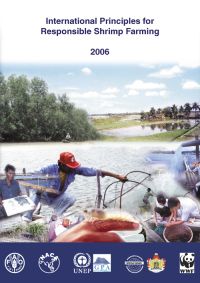Asia Regional Technical Guidelines on Health Management for the Responsible Movement of Live Aquatic Animals
19 November 2003 | 891 Downloads | .pdf | 420.45 KB | Crabs and lobsters, Freshwater finfish, Freshwater prawns, Governance and Policy, Health and Biosecurity, Marine finfish, Molluscs (shellfish and other), Shrimp
The Asia Regional Technical Guidelines on Health Management for the Responsible Movement of Live Aquatic Animals and their associated implementation plan, the Beijing Consensus and Implementation Strategy (BCIS), provide expert guidance for national and regional efforts in reducing the risks of disease due to trans-boundary movement of live aquatic animals. The Technical Guidelines were initiated due to increased recognition that disease emergence is often linked to live aquatic animal movements, and that the associated economic losses, including impacts on rural livelihoods and national efforts in poverty alleviation and food security, are highly significant. New trade agreements and requirements generated by the World Trade Organization (WTO) further reinforced the necessity for improved live aquatic animal health management. Recognising the need for a region-wide approach to aquatic animal health management, the national governments of countries of the Asia Region requested FAO, through NACA, to assist production of a set of technical guidelines that could be used to improve and harmonise aquatic animal health management strategies for responsible trans-boundary movement of live aquatic animals.
An FAO Technical Co-operation Programme (TCP) Project - “Assistance for the Responsible Movement of Live Aquatic Animals” was launched by NACA in 1998, with the participation of 21 countries from throughout the region. This programme complemented FAO's efforts in assisting member countries to implement the relevant provisions in Article 9 - Aquaculture Development - of the Code of Conduct for Responsible Fisheries (CCRF), at both the national and regional levels. A set of Guiding Principles, formulated by a group of aquatic animal health experts at the Regional Workshop held in 1996 in Bangkok, formed the basis for an extensive consultative process, between 1998-2000, involving input from government-designated National Co-ordinators (NCs), the Network of Aquaculture Centres in Asia-Pacific (NACA), FAO, the Office International des Épizooties (OIE), and regional and international specialists. The Technical Guidelines were unanimously endorsed at the Final Workshop on Asia Regional Health Management for the Responsible Trans-boundary Movement of Live Aquatic Animals, held in Beijing, China, 27 th -30 th June 2000.
Recognising the crucial importance of implementation of the Technical Guidelines, the participants prepared a detailed implementation strategy, the Beijing Consensus and Implementation Strategy (BCIS), focussing on National Strategies and with support through regional and international co-operation. The NCs gave unanimous endorsement of the Technical Guidelines, in principle, as providing valuable guidance for national and regional efforts in reducing the risks of disease due to the trans-boundary movement of live aquatic animals, and the workshop participants unanimously approved the associated implementation strategy.
Implementation of the Technical Guidelines will contribute to securing and increasing income of aquaculturists in Asia by minimising the disease risks associated with trans-boundary movement of aquatic animal pathogens. They will also contribute to regional efforts to improve rural livelihoods, within the broader framework of responsible management, environmental sustainability and protection of aquatic biodiversity.
Creative Commons Attribution.
